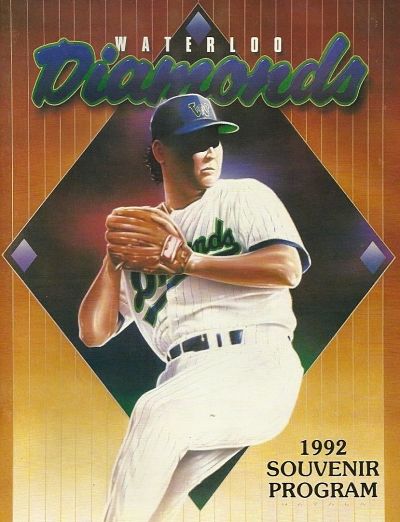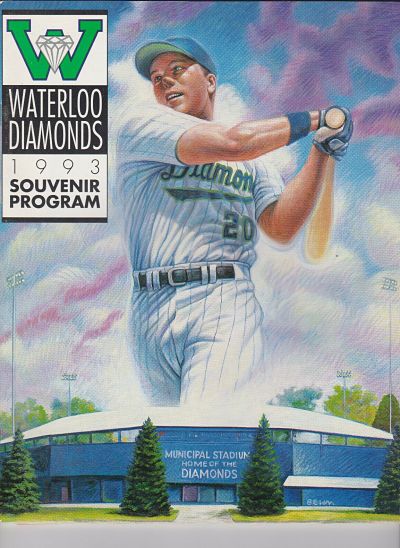Tombstone
Born: 1989 – Re-branded from Waterloo Indians
Moved: March 21, 1994 (Springfield Sultans)1Strasen, Marty & Jamison, Tim. “Report: Baseball is out of Waterloo”. The Courier (Waterloo, IA). March 22, 1994
First Game: April 10, 1989 (W 3-1 @ Burlington Braves)
Last Game: September 2, 1993 (L 5-1 vs. Springfield Cardinals)
Midwest League Championships: None
Stadium
Municipal Stadium (5,400)21992 Rockford Expos Program
Opened: 1946
Dimensions (1990): Left: 335′, Center: 375′, Right: 335′31990 Rockford Expos Program
Ownership & Affiliation
Owners:
- Waterloo Professional Baseball, Inc. (Dan Yates, Bill Boesen, et al.)
Major League Affiliations:
- 1989: Co-Op (Pittsburgh Pirates & San Diego Padres)
- 1990-1993: San Diego Padres
Attendance
Background
The Waterloo Diamonds were the last professional baseball team to make a home in the Eastern Iowa city of 68,000. The departure of the Diamonds in 1994 brought to an end a largely uninterrupted 90-year minor league tradition stretching back to the formation of the Waterloo Microbes in 1904.
The Diamonds formed in 1989 after the Waterloo Indians Midwest League franchise lost its Major League affiliation with the Cleveland Indians. The team operated in 1989 as a co-op operation, receiving players from both the Pittsburgh Pirates and San Diego Padres organizations. Co-op teams are typically awful and the 1989 Waterloo Diamonds were no exception. The club finished 47-89.

Midwest League’s Longest Game
On July 6, 1989, the Diamonds hosted the Clinton Giants at Municipal Stadium in Waterloo. The team’s battled to a 3-3 tie through 19 innings before the game was suspended due to curfew shortly before 1:00 AM. The game resumed in August 1989 and the clubs played another six innings before Mike King won it for Waterloo with a walk-off home run in the bottom of the 25th inning. It was the longest game in Midwest League history.
The Diamonds struck a parent club deal with the San Diego Padres in 1990. The team’s on-field fortunes improved only marginally. The team’s only winning campaign was the 1991 season (75-63). The 1991 club had a strong pitching staff that included future Major League regulars Bryce Florie, Lance Painter and Tim Worrell. The team returned to its losing ways in 1992 and 1993.
Waterloo Economic Decline
The Diamonds’ economic situation was even grimmer than the on-field product. Waterloo itself was in severe decline in the late 1980’s. The city’s Rath Packing Company, a major meatpacking employer, closed its doors in 1985. Manufacturing jobs were in decline. The U.S. Census showed a 12.5% decline in Waterloo’s population between 1980 and 1990.
In 1990, Major League Baseball and minor league baseball operators negotiated a contentious update to the Professional Baseball Agreement that governed relations between big league teams and their farm clubs. The new PBA shifted a greater burden for operating expenses to minor league owners and, most important, imposed stringent new minimum standards for ballparks that phased in during the early 90’s. The Agreement spurred the ballpark construction boom of the 1990’s and the resulting economic renaissance of the minor leagues. But it also marked the death knell of pro baseball for many small cities that lacked the political will or economic resources to build new stadiums. Waterloo’s dilapidated Municipal Stadium was a far cry from complying with the new standards.
During the 1992 season, a freelance writer named Richard Panek embedded himself with the Diamonds for the entire season. Panek’s resulting book, Waterloo Diamonds, focused on the changing economics of Rust Belt cities like Waterloo and of Minor League Baseball. Though Panek’s account concludes prior to the final departure of the Diamonds from Waterloo, the book depicts the conditions that led to the end of pro ball in the city.

New Ownership & Move to Illinois
Chicago advertising executive Tom Dickson, his wife Sherrie Myers purchased the Diamonds in late 1993 with the aim of moving the team to a new ballpark in Lake County, Indiana. That idea was blocked by Major League Baseball’s territorial rules (the Cubs and White Sox objected).
The prospect of new ownership only exacerbated the Diamonds’ often contentious relationship with Waterloo’s political leadership. City officials demanded $500,000 of the departing ownership group from proceeds of the reported $2 million sale price to cover prior improvements to Municipal Stadium as a condition of renewing the Diamonds’ $1.00 annual lease for the 1994 season. Team and Midwest League officials balked at the demand and scrambled to move the team to Springfield, Illinois mere weeks before opening day.
The former Diamonds became known as the Springfield Sultans for the 1994 Midwest League season. The franchise moved again in 1996 to Lansing, Michigan where it remains to this day, now known as the Lansing Lugnuts.
The Waterloo Bucks amateur collegiate team formed in 1995 to replace the Diamonds at Municipal Stadium. The Bucks enter their 23rd season of operation in 2017.
Links
##


3 Responses
I have the book about the Waterloo Diamonds in my bedroom. Nice read. Bought it in 1 of the shops in Cooperstown, NY.
Hi – i came across a team signed Waterloo diamond ball – has lots of signatureS – any value ?
Yes, but probably only of the sentimental kind.
Drew